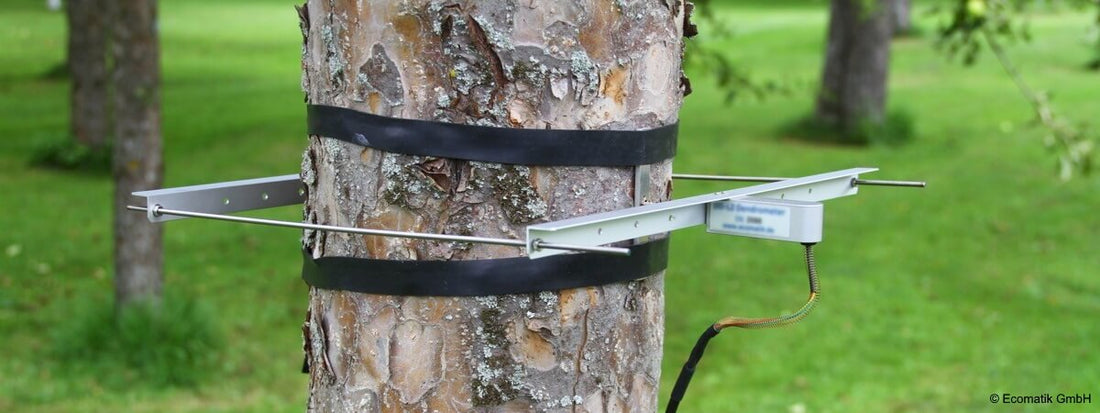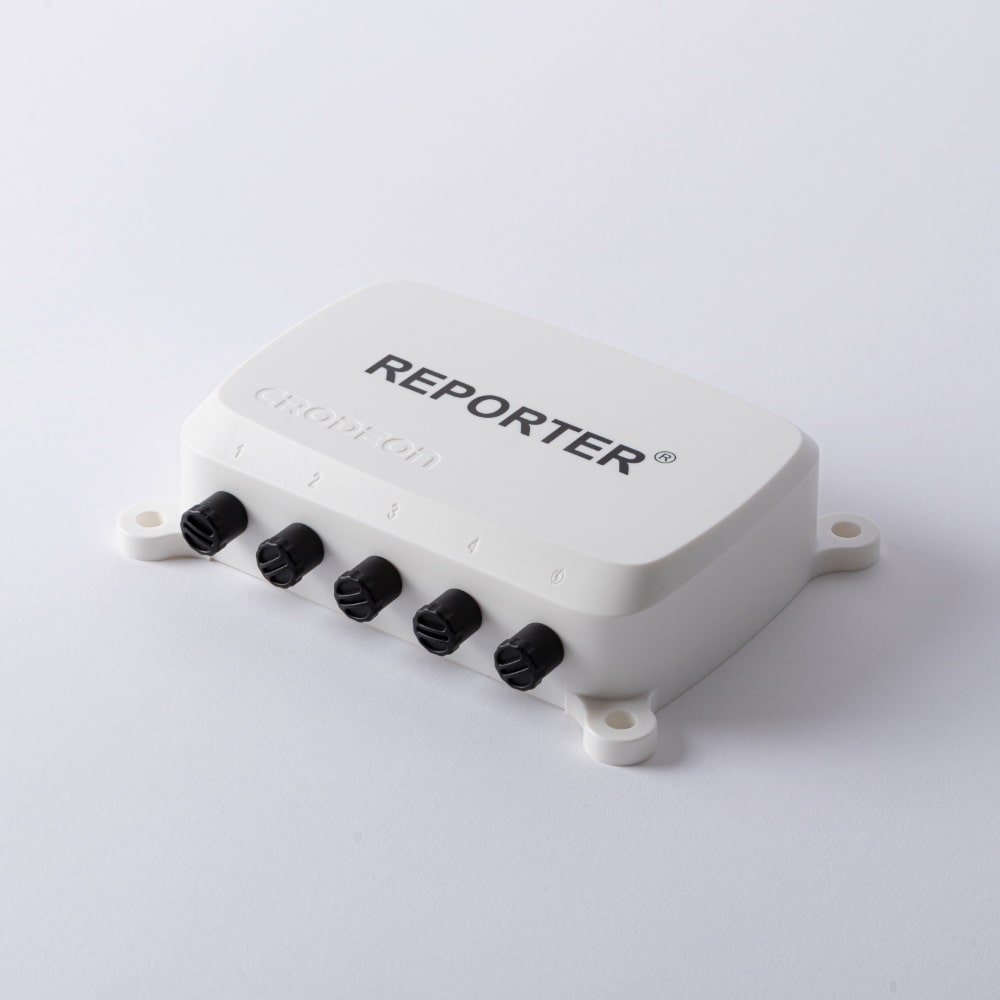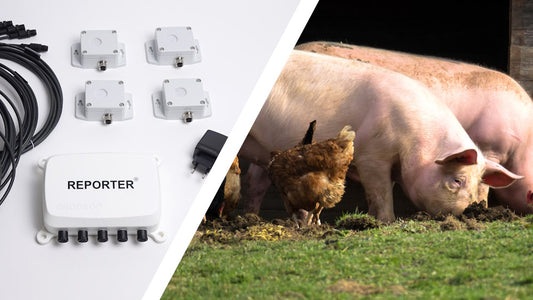Innovative tree monitoring: Ecomatik dendrometer integrated with Reporter

To get the optimal fruit harvest you have to listen to your trees. Luckily, we don't even have to be tree whisperers to understand them! Thanks to modern technology, this is no longer a distant dream.
Reporter, a leading data monitoring device, seamlessly integrates with Ecomatik's dendrometer. This enables many new possibilities for monitoring the growth and watering status of fruit and trees.
In this blog post, we will explore the use of dendrometers and how you can connect them to Reporter to revolutionise agricultural and research practices.
Unrivalled dendrometer sensor precision by Ecomatik
When it comes to dendrometers, Ecomatik's experience is unrivalled. With measurement resolution up to 0.2 μm the sensors capture growth and shrinkage in trunks, branches, roots, and fruit. This valuable data gives you concrete insights into the health and growth of your plants as well as keeping you updated about the state of your fruit harvest.
Ecomatik's dendrometers are available for measuring tree trunks, stems, branches, roots, and fruit (from apples to cherries and grapes).
The advantages of a dendrometer
As a dendrometer collects data connected to the growth and shrinkage of plant parts, it gives valuable insights for everyone who needs to monitor their plants closely. Different measurements benefit different applications. Let's have a look at the most common uses of a dendrometer.
Advantages for fruit farmers
A dendrometer will help you log and monitor growth patterns and health in your plants. This allows you to increase irrigation or anticipate when to harvest your fruit. It can even help you save water by limiting irrigation when you want to increase the sugar content in your fruit. All of this combined helps you harvest the best quality fruit from healthy trees.
Monitoring growth progress
By installing a dendrometer as an agriculturalist, you can keep track of the growth of the trunk over the years. In graph (A) below you can see a stem growth curve from almost three growing seasons increasing from 2000 µm to over 7000 µm. We can identify stem diameter growth, the annual growth rate increment and freezing periods with strong stem shrinkage. These are all important parameters helping you to track health and vigour in your plants.

When zooming in on the growth of one month in graph (B), we can see how the trunk behaves on a daily basis. We can clearly identify the day/night cycle and how these are affected by dry periods and rainfalls. The amplitude between daily shrinking and nightly swelling of the stem directly corresponds to the extent of which the plant has to use up its internal water storage. These internal pools can buffer a high daily transpiration demand. Swelling of the stem at night shows the plant's ability to replenish these water reserves.
Tracking water availability for juicy fruit
When we measure the diameter of the trunk through the dendrometer, in combination with soil moisture, some interesting effects can be noted. The graph below shows the diurnal (daily) behaviour of the trunk over a period of one month. We can identify four different conditions of soil water availability during this month indicated in green (well watered, luxury), yellow (mild water shortage), red (water shortage) and dark red (drought).
During the days marked in green, this tree got plenty of water, so it was able to supply daily transpiration almost completely from instantaneous water uptake and the diurnal amplitude is small. During the week marked in yellow, the tree was still able to take up enough water during nighttime to compensate for daily transpiration losses, except that transpiration was fed to a larger extent from the internal water resources (larger amplitude).
During the weeks marked in red and dark red, there was more transpiration during the day than water uptake at night. We can clearly notice a shrinking trunk in the data. Unfortunately, this also results in a lower fruit yield for this tree, even though the uptake and trunk diameter are restored to healthy levels on October 7th.
Now here comes the best part. Whereas in the early expansion phase of fruit development, we would like to remain in the green area and avoid limitations of rapid fruit growth, it is the occurrence of “yellow” periods with high uptake and high transpiration that make fruit-carrying plants perform at their best in later phases of fruit ripening. It's this kind of mild water shortage in such periods, where higher concentrations of compounds are being produced that give fruits a flavourful taste.
This data and insights give fruit growers valuable tools to manage and optimise water use, yield and fruit quality.
Knowing when it's time to harvest
One final example that we will cover in this blogpost concerns cherries, but it's also relevant for many other pome fruits. All fruits stop growing at a certain point, but fruits such as cherries, will even shrink when they are softening due to ripeness.

As a grower, when you see the growth curve is flattening, you can anticipate that you will soon be harvesting and you can learn about the ideal timing to do so.
Benefits for research institutions
For research institutions, accurate and continuous data collection is invaluable. Using a dendrometer for scientific research helps to efficiently gather precise, objective, and reliable data, without the arduous manual labour. Either in a permanent set-up or as a temporary solution. It allows for detailed long-term studies that can drive innovation in agricultural practices.
Vlaanderen WaterProof
During their ‘Flanders WaterProof’ project, research institution VITO (aided by pcfruit) researched irrigation in pear trees. They used a dendrometer combined with Watermark soil tension sensors to determine the precise amount of irrigation water a pear tree requires to give a good yield while preventing water spillage.
"At night, the trunk expands as trees absorb maximum moisture through the roots. During the day, the trees shrink. The rate at which they shrink is therefore an indicator of how much moisture a tree absorbs. Do they absorb enough moisture or do they enter a state of stress due to lack of moisture? If the trunk increases less at night than it shrinks during the day, the tree is clearly thirsty." - Flanders WaterProof, efficient water use

Read the blog below to learn more about this project:
Applications in other sectors
Dendrometers can also be used in other ways, for example:
- Forestry Management: Monitoring tree growth for sustainable forestry practices.
- Environmental Studies: Studying the impact of environmental changes on plant growth.
- Urban Green Spaces: Managing urban trees and green spaces effectively.

Connecting a dendrometer to the cloud
Collecting growth and shrinkage data using your dendrometer sensors is incomplete without a reliable data logger to collect and save this data. Meet Reporter, our mobile and versatile sensor module for remote monitoring and data collection. Reporter is a cutting-edge device designed to provide real-time data monitoring for various applications. Its versatility makes it an essential tool for anyone needing precise and continuous data collection.
The sensor module connects to the cellular data network (2G/4G) and streams its live data to the cloud in real-time. Here this data gets saved while it remains accessible to you 24/7 through your internet browser of choice. You can access the cloud platform (Crodeon Dashboard) through a user-friendly web app that does not require software to be downloaded. Reporter is powered through the power grid or by its own small solar panel.
Reporter's installation works plug & play, meaning that you just plug your sensor into the module to connect. The seamless integration of Crodeon's Reporter with Ecomatik's dendrometer is a game-changer, offering unparalleled data accuracy and ease of use.
Combining dendrometers with other sensors
Reporter has four sensor connectors, meaning that you can connect four dendrometers, or a combination of dendrometers, soil moisture sensors like the Watermark or SMT100, a weather station and a leaf wetness sensor. Don't forget the PAR light sensor to measure the amount of useful sunlight!
Whatever combination your project requires, Reporter's pick & mix sensor availability makes it possible. Have a look at our vast collection of sensors and assemble your personal measuring kit.
Watch the webinar below to learn more about Reporter's compatibility with other plant sensors.
Questions?
Don't hesitate to reach out to us if you have any questions, we're here to help!











